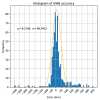Reliable Identification Schemes for Asset and Production Tracking in Industry 4.0
- PMID: 32630771
- PMCID: PMC7374395
- DOI: 10.3390/s20133709
Reliable Identification Schemes for Asset and Production Tracking in Industry 4.0
Abstract
Revolutionizing logistics and supply chain management in smart manufacturing is one of the main goals of the Industry 4.0 movement. Emerging technologies such as autonomous vehicles, Cyber-Physical Systems and digital twins enable highly automated and optimized solutions in these fields to achieve full traceability of individual products. Tracking various assets within shop-floors and the warehouse is a focal point of asset management; its aim is to enhance the efficiency of logistical tasks. Global players implement their own solutions based on the state of the art technologies. Small and medium companies, however, are still skeptic toward identification based tracking methods, because of the lack of low-cost and reliable solutions. This paper presents a novel, working, reliable, low-cost, scalable solution for asset tracking, supporting global asset management for Industry4.0. The solution uses high accuracy indoor positioning-based on Ultra-Wideband (UWB) radio technology-combined with RFID-based tracking features. Identifying assets is one of the most challenging parts of this work, so this paper focuses on how different identification approaches can be combined to facilitate an efficient and reliable identification scheme.
Keywords: Industry 4.0; IoT; asset tracking; low-cost tracking.
Conflict of interest statement
The authors declare no conflict of interest.
Figures














References
-
- DIN Standards . Reference Architecture Model Industrie 4.0 (RAMI4.0) DIN; Berlin, Germany: 2016. DIN SPEC 91345.
-
- Kozma D., Soos G., Varga P. Supporting Digital Production, Product Lifecycle and Supply Chain Management in Industry 4.0 by the Arrowhead Framework–A Survey; Proceedings of the IEEE International Conference on Industrial Informatics (INDIN); Helsinki, Finaland. 22–25 July 2019.
-
- Barreto L., Amaral A., Pereira T. Industry 4.0 implications in logistics: An overview. Procedia Manuf. 2017;13:1245–1252. doi: 10.1016/j.promfg.2017.09.045. - DOI
-
- Perez-Guirao , Kull B., Luediger H. An ultra-wideband approach towards autonomous radio control and positioning systems in manufacturing & logistics processes; Proceedings of the 4th Workshop on Positioning, Navigation and Communication; Hannover, Germany. 22–22 March 2007.
-
- Productive 4.0. [(accessed on 30 June 2020)]; Available online: https://productive40.eu/about/
LinkOut - more resources
Full Text Sources

